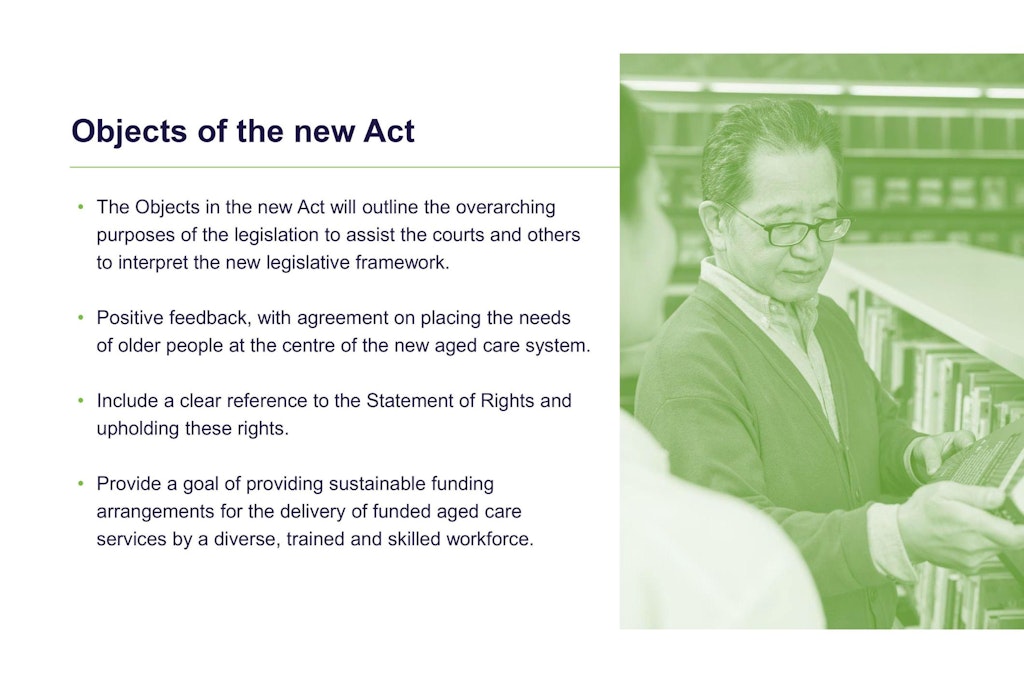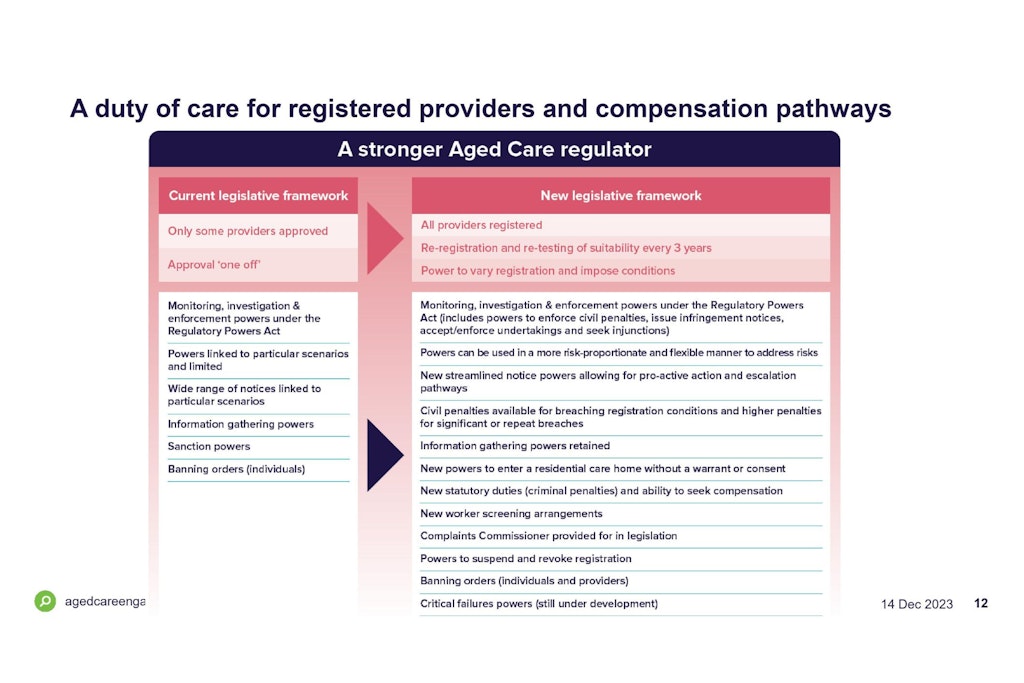Digging into the features of the new Aged Care Act
Published on 18 December 2023 (Last updated on 22 December 2023)

The Government has just released the Exposure Draft of the New Aged Care Act, setting into motion the next phase of aged care reform.
The detailed document will be the foundation for a new aged care system, according to Mel Metz, Assistant Secretary of the Legislative Reform Branch. Enshrining the rights of older people and providing more support and guidance to aged care users has underpinned its design, but there’s far more to uncover.
Ms Metz explored key elements of the draft in the New Aged Care Act and Support at Home Program update and we have broken down her insights.
Objects, concepts and definitions
The foundations of the Aged Care Act are laid in Part 2 – Definitions and key concepts. Here, the proposed objects of the Aged Care Act explain the purpose of the legislation, while concepts and definitions provide clear and accurate reference points for providers, stakeholders, courts, etc.
Stakeholder feedback resulted in some significant inclusions, explained Ms Metz.
“First, feedback on the proposed objects was positive with broad support for placing the needs of older people at the centre of the new aged care system,” she said.
“Second, we heard that you wanted a clear reference to the Statement of Rights in the objects we included. Third, we heard that it was important to reference sustainable funding arrangements and the delivery of services by a diverse, trained and skilled workforce.”
With seven overarching objects of the act, Ms Metz added that some are more structurally critical or constitutionally significant. These are further explored in Sections 7 and 8.
“The new aged care service list is structurally important. It will for the first time, make it clear to everyone in legislation what aged care services the Commonwealth funds. This sets us up to introduce Support at Home in 2025 and provides the basis for the new provider registration model which groups the services on the list into registration categories,” said Ms Metz.
New and updated definitions have been included, such as ‘significant failure’, ‘systemic pattern of conduct’ and ‘high quality care’.

The Statement of Rights
The Statement of Rights is a new addition focusing on what older people accessing or seeking access to funded aged care services can expect from registered providers. This is provided alongside the aged care principles which explain the expected actions of the people or bodies who operate under the Act. Both have been influenced by feedback, leading to more descriptive references, empowering language and enforceability mechanisms.
“Section 21 in the Exposure Draft contains a clear expectation that registered providers must not act in a way that is incompatible with the Statement of Rights, taking into account the need to balance other competing or conflicting rights. This is supported by a registration condition,” explained Ms Metz.
“This condition requires registered providers to demonstrate they have practices in place to make sure they uphold these rights and provide older people with information about their rights. Where this isn’t the case a provider may be in breach which can lead to a number of regulatory responses.”
Stronger aged care regulation
Chapters 3, 5 and 6 cover all key elements involved in establishing a stronger aged care regulator. This includes new registration processes for aged care providers (Chapter 3), the governance of the aged care system (Chapter 5) and regulatory mechanisms (Chapter 6).
Chapter 6 outlines a new power for Commission officers to enter premises without warrant or consent if there is a serious risk to a person’s life, health or well-being, a power recommended by the Royal Commission.
Meanwhile, some conditions apply to all aged care providers to ensure quality care is delivered, such as:
- Complying with the Code of Conduct
- Meeting worker screening requirements
- The Rights and principles related conditions
- Protecting personal information and record-keeping
- Fees and payments
- Incident management or SIRS (Serious Incident Response Scheme)
- Complaints and whistleblower requirements
“Under the new system, all aged care providers will need to be registered and that registration is subject to a number of conditions. Section 88 creates a general requirement for providers to comply with conditions with two levels of civil penalties where they fail to do so,” said Ms Metz.

Conduct that breaches a condition attracts up to 250 penalty units and conduct that involves a significant failure or systemic pattern of conduct attracts up to 500 penalty units. The Aged Care Quality and Safety Commissioner is able to impose those specific conditions.”
Breaching a provider obligation may attract a civil penalty, constitute a criminal offence or lead to regulatory responses. Breaching new duties on registered providers, responsible persons and platform providers (Chapter 1, Part 4) is a criminal offence and the Commissioner or an individual can seek compensation through the courts.
There are no duties on aged care workers with existing banning orders deemed a sufficient response.
Information management and whistleblowers
Ms Metz wrapped up by outlining the proposed information management legislation in Chapter 7. There are limits on recording using and disclosing protected information that is obtained or generated concerning the Act, including personal information or something that could prejudice the financial interests of a provider.
“This represents a change from the current Act that protects any information about an approved provider, an approach that was criticised by the Royal Commission,” said Ms Metz.
“We will also be removing the broad FOI [Freedom of Information ]protections that were criticised by the Royal Commission.”
Additionally, the new whistleblower framework forms a critical part of the Act as it aims to protect people making complaints. Any person can be a whistleblower and will be protected if they provide information to the Commission, Department of Health and Aged Care, a provider or police.
“The disclosure can be made orally or in writing, but the person making the disclosure must have reasonable grounds to suspect that a person or entity may have contravened the Act. The whistleblower no longer needs to provide their name to be offered protection, ensuring that potential whistleblowers feel safe to make disclosures,” added Ms Metz.
More information and supporting documents are available, including Consultation paper no. 2 (and in a Plain English version) and a Consultation summary report.